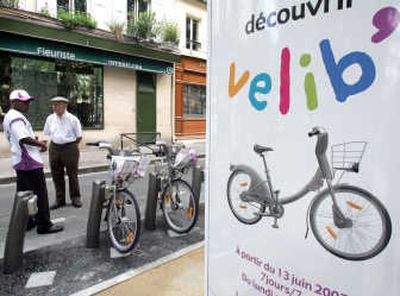Make your own tour de France

PARIS – It was a perfect Paris moment: The rain cleared, the sky filled with blue, and I was flying across town on a bicycle, past the Louvre, along the Seine River, through a public garden and up a cobblestone market street.
As a tourist in Paris, it’s easy to spend at least an hour every day in the Metro, but sometimes you need to come up for air. After taking a test run of Paris City Hall’s inexpensive, easy-to-use new bike service, I pledged to spend less time this summer in the city’s underworld and more time out joyriding.
Starting last Sunday, more than 10,600 bikes have been posted all over town at 750 stations, and the numbers of both will nearly double by the year’s end. The great news for tourists is that City Hall has made sure the service is convenient for tourists, not just Parisians, by offering short-term passes and access in eight languages.
Velib’, as the service is called, is a word made up by blending together “velo” (bike) and “liberte” (liberty). The idea is flexibility: You grab a bike from any station around town – they pop up every 330 yards or so – and park it at any other station. That means you don’t have to haul the bike back to your hotel if your feet hurt or it starts raining.
The program is Socialist Mayor Bertrand Delanoe’s latest effort to make Paris more green and bike-friendly, after ripping up car lanes to install bike paths – much to the angst of some drivers, who complain there are more bottlenecks now.
Today, there are 230 miles of bike lanes in Paris, and City Hall says the amount of bike traffic has increased nearly 50 percent since 2001. The city isn’t a paradise for bikers yet – there’s still a lot of car traffic and confusing one-way streets – but a ride is no longer the obstacle course it once was.
By launching the bike program, Paris is following in the footsteps of European cities including Stockholm, Vienna, Barcelona, Brussels and Copenhagen. The German railway system has a bicycle rental program in which you unlock rental bikes at rail stations using your cell phone.
A service similar to Velib’ has been a hit in Lyon, France, inspiring Paris to try it, too. In Lyon, every bike is used seven to 15 times a day, and the average number of rides a day is upward of 15,000.
The Paris plan already has more than 6,000 annual subscribers. A yearlong pass is $39.50, while a one-day pass costs a euro (about $1.36) and a seven-day ticket goes for five euros (about $6.80).
You’ll wind up paying slightly more than that if you keep the bike for more than half an hour at a time.
The first half-hour after you pick up a bike is always free, with an extra euro tacked on for the first additional half-hour, two euros for the second and four euros for every extra half-hour from then on.
The sliding price scale, conceived to keep the bikes in rotation, means that if you want to spend a leisurely day riding through the gardens of the Bois de Boulogne, it would be cheaper to rent a bike from a shop.
But if you want to stop at the Louvre, then head to the boutiques of the Saint Germain neighborhood for some shopping, then crash at your hotel in eastern Paris – with the flexibility to take a bus or the Metro instead, if you’re tired – then Velib’ is your best bet.
Here’s how it works:
Stop in at any station around town with your credit card. They accept American Express, Visa and MasterCard, among others.
Each station comes with an electronic vending machine with instructions in eight languages. Select “English,” and the machine will walk you through the instructions. Along the way, you must authorize Velib’ to deduct $205 from your card if the bike is not returned within 24 hours. (For a one-year subscription, you have to sign up online or by mail to use the service, but for a one- or seven-day pass, you can do it at the machine.)
The bikes are rather utilitarian: three-speed touring bikes, weighing nearly 50 pounds each. Once you’ve picked one out, you have 60 seconds to push a button on the stand and pull the bike free. Adjust the seat, and you’re ready to go.
The bike has a basket and a built-in lock, so you can secure it if you need to run into a shop or make a quick stop. For longer stops, you’ll save money if you return the bike to a station.
To put the bike back, you slide it into the stand, and you’ll hear a beep and see a blinking light if it’s attached correctly. Be sure to push it in firmly.
One drawback for the tourist: Since the stations are not manned, there’s no one to ask for help with directions, so bring a map and be prepared to stop a passer-by if you get lost.
On my test ride, I did a reconnaissance mission for what I would consider the perfect summer afternoon-into-evening, when the sun stays out until after 10 p.m.
The itinerary: Pick up a bike near your hotel and head to the Palais Royal gardens, a quiet rose-filled square in the middle of town, for a coffee or a stroll. From there, head by foot to nearby rue Montorgueil, a market street where you can buy cheese, baguettes and a bottle of wine.
Grab a bike at the rue des Petits Carreaux station and park it at the Pont Saint Louis station near the Seine, and look for a spot on the quays for your picnic blanket.